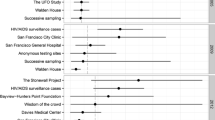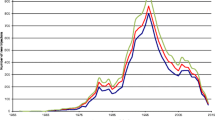Abstract
This article estimates the population prevalence of current injection drug users (IDUs) in 96 large US metropolitan areas to facilitate structural analyses of its predictors and sequelae and assesses the extent to which drug abuse treatment and human immunodeficiency virus (HIV) counseling and testing are made available to drug injectors in each metropolitan area. We estimated the total number of current IDUs in the United States and then allocated the large metropolitan area total among large metropolitan areas using four different multiplier methods. Mean values were used as best estimates, and their validity and limitations were assessed. Prevalence of drug injectors per 10,000 population varied from 19 to 173 (median 60; interquartile range 42–87). Proportions of drug injectors in treatment varied from 1.0% to 39.3% (median 8.6%); and the ratio of HIV counseling and testing events to the estimated number of IDUs varied from 0.013 to 0.285 (median 0.082). Despite limitations in the accuracy of these estimates, they can be used for structural analyses of the correlates and predictors of the population density of drug injectors in metropolitan areas and for assessing the extent of service delivery to drug injectors. Although service provision levels varied considerably, few if any metropolitan areas seemed to be providing adequate levels of services.
Similar content being viewed by others
References
Crofts N, Louie R, Rosenthal D, Jolley D. The first hit: circumstances surrounding initiation into injecting. Addiction. 1996;91:1187–1196.
Irwin K, Edlin B, Faruque S, et al. Crack cocaine smokers who turn to drug injection: characteristics, factors associated with injection, and implications for HIV transmission. Drug Alcohol Depend. 1996;42:85–92.
Khantzian E. The self-medication hypothesis of substance use disorders: a reconsideration and recent applications. Harv Rev Psychiatry. 1997;4:231–244.
Dunn J, Laranjeira R. Transitions in the route of cocaine administration—characteristics, direction, and associated variables. Addiction. 1999;94:813–824.
Weinberg N, Glantz M. Child psychopathology risk factors for drug abuse: overview. J Clin Child Psychol. 1999;28:290–297.
Strakowski S, DelBello M. The Co-occurrence of bipolar and substance use disorders. Clin Psychol Rev. 2000;20:191–206.
Swendsen J, Merikangas K. The comorbidity of depression and substance use disorders. Clin Psychol Rev. 2000;20:173–189.
Fuller C, Vlahov D, Arria A, Ompad D, Garfein R, Strathdee S. Factors associated with adolescent initiation of injection drug use. Public Health Rep. 2001;116(suppl 1):136–145.
Neaigus A, Miller M, Friedman S, et al. Potential risk factors for the transition to injecting among non-injecting heroin users: a comparison of former injectors and never injectors. Addiction. 2001;96:847–860.
Wallace D, Wallace R. A Plague on Your Houses. New York: Verso; 1998.
Friedman SR, Perlis TE, Des Jarlais DC. Laws prohibiting over-the-counter syringe sales to injection drug users: relations to population density, HIV prevalence and HIV incidence. Am J Public Health. 2001;91:791–793.
Nurco DN, Shaffer JW, Cisin IH. An ecological analysis of the interrelationships among drug abuse and other indices of social pathology. Int J Addict. 1984;19:441–451.
Hunt L, Chambers C. The Heroin Epidemics: a Study of Heroin Use in the United States, 1965–75. New York: Spectrum; 1976.
Novick DM, Haverkos HW, Teller DW. The medically ill substance abuser. In: Lowinson JH, Ruiz P, Millman RB, Landgrod JG, eds. Substance Abuse: a Comprehensive Textbook. 3rd ed. Baltimore, MD: Williams and Wilkins; 1997:534–550.
Office of Management and Budget. Standards for defining metropolitan and micropolitan statistical areas. 65 Federal Register 8228–82238 (2000).
US Bureau of the Census. State and Metropolitan Area Data Book, 1997–1998. Washington, DC: US Bureau of the Census; 1998.
Holmberg SD. The estimated prevalence and incidence of HIV in 96 large US metropolitan areas. Am J Public Health. 1996;86:642–654.
Office of Applied Studies, Substance Abuse and Mental Health Services Administration. National Household Survey on Drug Abuse. 1998.
Wright D, Gfroerer J, Epstein J. Ratio estimation of hardcore drug use. J Official Stat. 1997;13:401–416.
Turner CF, Ku L, Rogers SM, Lindberg LD, Pleck JH, Sonenstein FL. Adolescent sexual behavior, drug use, and violence: increased reporting with computer survey technology. Science. 1998;280:867–873.
Substance Abuse and Mental Health Services Administration. Uniform Facility Data Set (UFDS): 1998: data on substance abuse treatment facilities. Available at: http://wwwdasis. samhsa.gov/98ufds/ufds98_m.htm. Accessed March 17, 2004.
Frischer M, Hickman M, Kraus L, Mariani F, Wiessing L. A comparison of different methods for estimating the prevalence of problematic drug misuse in Great Britain. Addiction. 2001;96:1465–1476.
Centers for Disease Control and Prevention. HIV Counseling and Testing in Publicly Funded Sites. Annual Report 1997–1998. Atlanta, GA: Centers for Disease Control and Prevention; 1999.
Friedman SR, Perlis TE, Lynch J, Des Jarlais DC. Economic inequality, poverty, and laws against syringe access as predictors of metropolitan area rates of drug injection and HIV infection. In NIDA (Eds.): 2000 Global Research Network Meeting on HIV Prevention in Drug-Using Populations. Third Annual Meeting Report. Durban, South Africa, July 5–7, 2000. Washington, DC: US Department of Health and Human Services; 2001:147–149.
Lurie P, Reingold AL, Bowser B, et al. The Public Health Impact of Needle Exchange Programs in the United States and Abroad, Volume 1. Rockville, MD: CDC National AIDS Clearinghouse; 1993.
Lynch JW, Kaplan GA, Pamuk ER, et al. Income inequality and mortality in metropolitan areas of the United States. Am J Public Health. 1998;88:1074–1080.
US Department of Health and Human Services. AIDS Public Information Data Set. Washington, DC: US Dept of Health and Human Services; 2000:1–52.
Lieb S, Friedman SR, Zeni MB, et al. An HIV prevalence-based model for estimating urban risk populations of injection drug users and men who have sex with men. J Urban Health. 2004;81:401–415.
Author information
Authors and Affiliations
Rights and permissions
About this article
Cite this article
Friedman, S.R., Tempalski, B., Cooper, H. et al. Estimating numbers of injecting drug users in metropolitan areas for structural analyses of community vulnerability and for assessing relative degrees of service provision for injecting drug users. J Urban Health 81, 377–400 (2004). https://doi.org/10.1093/jurban/jth125
Issue Date:
DOI: https://doi.org/10.1093/jurban/jth125




